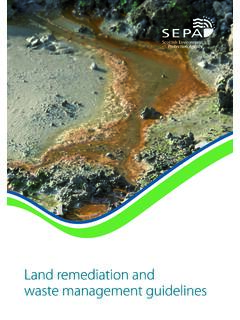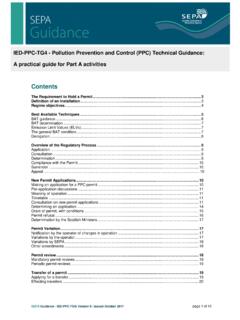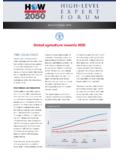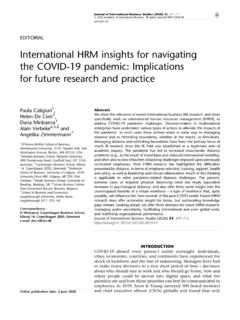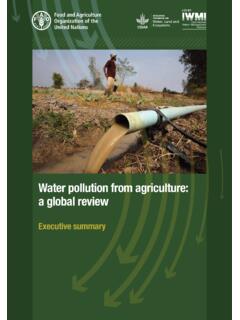Transcription of Guide to Waste Management
1 May 2009 0 Table of Contents 3 3 Principles of 3 About this 3 Relationship with planning 4 Relationship with Pollution Prevention and Control (Scotland) Regulations 5 Relationship with other 5 Other Waste Management 6 Environmental policies and their 6 Licence Applications and Licence 7 Introduction the purpose of licence 7 Applications for 8 Preparation of the working plan .. 9 Relationship between Licence Conditions and the Working 10 Drafting Licences .. 11 Supervising operators compliance .. 11 Public Register .. 12 Fit and Proper 13 13 Conviction for a relevant 13 Technical 18 Financial 21 Considerations for Licensing of all 24 24 Site 24 Site 24 24 Waste 24 25 Weatherproof 25 Site 25 Mud ..26 Types of Waste .. 26 Receipt of 26 Quantities of 26 Manning and Management systems .. 27 27 Plant 27 Pollution control and environmental 28 29 Site completion & Licence 30 May 2009 1 Additional Considerations for Licensing Specific Types of 31 31 Transfer 31 Civic Amenity Sites and Household Waste Recycling 31 Waste Electrical and Electronic Equipment (WEEE).
2 32 Ozone Depleting 32 Treatment 33 34 34 End of Life Vehicle Facilities (ELVS).. 35 Oil and Solvent Recovery 36 Hazardous Waste Transfer 36 Mobile Plant .. 36 Healthcare 37 Licence Modifications, Transfer & 39 39 39 39 Standards for 40 The completion 40 42 Useful Links .. 43 May 2009 Introduction Background This document provides guidance to SEPA staff in relation to Waste Management licensing. The majority of Waste Management facilities are licensed by way of a Waste Management Licence issued under The Waste Management Licensing Regulations 1994. Some facilities fall to be licensed under a PPC permit (issued under The Pollution Prevention and Control (Scotland) Regulations 2000) or an exemption from the Waste Management Licensing Regulations; this document does not seek to cover these regimes.
3 The provision for a system of Waste Management licensing is set out in Sections 33, and 35-42 of the Environmental Protection Act 1990 ( The 1990 Act ). The document should be read in conjunction with the 1990 Act, and the Waste Management Licensing Regulations 1994. SEPA staff should also consult the Waste Management Licensing Manual which contains SEPA s procedures and application forms. For external users of this document please contact local SEPA teams if you wish to discuss issues in further detail. Principles of licensing The objective of the Waste Management licensing system is to ensure that Waste Management facilities do not; Cause pollution of the environment Cause harm to human health Become seriously detrimental to the amenities of the locality Pollution and harm are defined in section 29 of the 1990 Act.
4 In assessing pollution, SEPA should have regard to the wider environment. SEPA should, for example, consider the impacts of emissions on global climate change as well as on local air, water, soil, flora and fauna. About this document Although Waste Management facilities vary widely, the fundamental consideration in licensing them is always the same. The licence seeks to prevent unacceptable emissions to land , air or water: it achieves this by specifying the Management and control systems for the site or plant. The detail of the licence, however, will vary from one type of facility to another. Most Waste facilities need to be controlled by a licence to manage the Waste input, storage and treatment processes to control liquid spillages, adverse Waste interactions, and emissions of noise, dust and litter.
5 May 2009 3 This document is structured as follows; Chapter 1 gives detail on the background of licensing and the relationship with planning and other legislation. Chapter 2 advises on the relationship between licence conditions and the working plan. Chapter 3 contains detail on Fit and Proper Person Chapter 4 gives guidance on those aspects of licence control that are applicable to all or most types of facility. Chapter 5 contains guidance specific to the individual types of facility: it is sub-divided by type of facility. Chapter 6 contains guidance on surrender, transfer and modification of a licence. Chapter 7 provides links to useful documents and websites. Relationship with planning legislation Under section 28 of the Town and Country Planning (Scotland) Act 1997 subject to certain conditions, planning permission is required for the carrying out of any development of land .
6 Therefore the appropriate planning permission should be in place prior to the development of a Waste Management facility. Exceptions to this will be if an established use certificate or certificate of lawful use is in force for the land in question. This means that planning authorities and SEPA must achieve close co-ordination over proposals for developing Waste Management facilities. The planning function and the licensing function should complement each other, rather than duplicating controls. The planning system controls the development and use of land in the public interest. It therefore has an important role to play in determining the location of development including Waste Management and disposal facilities. Important issues in the context will be The impact of the development on local amenities The potential for contamination The prevention of nuisance Traffic and access considerations, and Matters relating to restoration after-care and after-use If a Waste facility might cause pollution, the possibility will almost certainly be a material consideration in the determination of a planning application for the facility.
7 In particular, many Waste Management facilities will need to be subject to an Environmental Assessment Environmental Impact Assessment (Scotland) Regulations 1999 May 2009 4 The Environmental Assessment must assess, among other things the facility s potential for causing environmental pollution, and the applicant s proposals for mitigating it. SEPA would expect to be consulted by those undertaking Environmental Assessment during the assessment process. If any pollution is likely to affect land use, either at the site in question or in the surrounding area, the planning authority may need to take account of it, and may also need to consider whether anti-pollution systems and controls are compatible with, or adequate in view of, the wider planning objectives. That said, planning controls are not an appropriate means for the detailed control of pollution from Waste Management facilities.
8 This should always be done by SEPA through the licensing system. In the same way, licence conditions should not cover issues which are fundamentally about development and land use, except where there is no planning permission. Relationship with Pollution Prevention and Control (Scotland) Regulations 2000 Some Waste Management activities fall outwith the Waste Management Licensing Regulations ( landfilling, incineration and disposal of hazardous Waste ) and under the Pollution Prevention & Control (PPC) regime. The Pollution Prevention & Control (Scotland) Regulations 2000 enact the IPPC Directive. The PPC regulatory regime uses an integrated approach to the regulation of activities specified in the PPC Regulations through the permitting of the prescribed process and any directly associated activities on the same site.
9 For certain types of installation there are other legislative requirements, for example: Incineration The Waste Incineration (Scotland) Regulations 2003 transpose the Waste Incineration Directive. The Waste Incineration Directive is being implemented through the PPC Permitting regime. Landfill The Landfill (Scotland) Regulations 2003 implement the stringent operational and technical requirements of the EU Landfill Directive and detail the issues that must be conditioned in a Landfill Permit. Permitting of landfills is implemented through the PPC regime. Relationship with other legislation Discharges to water Regulation 18 of the Water Environment (Controlled Activities) (Scotland) Regulations 2005 (CAR) allows for a Waste Management licence to be regarded as an authorisation for the purpose of the Controlled Activities Regulations.
10 Therefore, cognisance must be made of the requirements of the relevant water legislation in the licensing process. This means that abstractions and discharges of surface waters and groundwaters can be licensed under a Waste Management licence so long as it complies with CAR. For more information on the requirements of CAR please refer to SEPA s Water Manual May 2009 5 Health, safety and welfare at work Regulation 13 of the Waste Management Licensing Regulations 1994 provides that no licence condition shall be imposed for the purpose only of securing the health of persons at work. Requirements relating to the health, safety and welfare of persons at work are administered by the Health and Safety Executive (HSE) or Local Authorities. The inclusion in a licence of conditions which relate only to the health, safety and welfare of persons at work could interfere with enforcement of the statutory obligations of the HSE.




